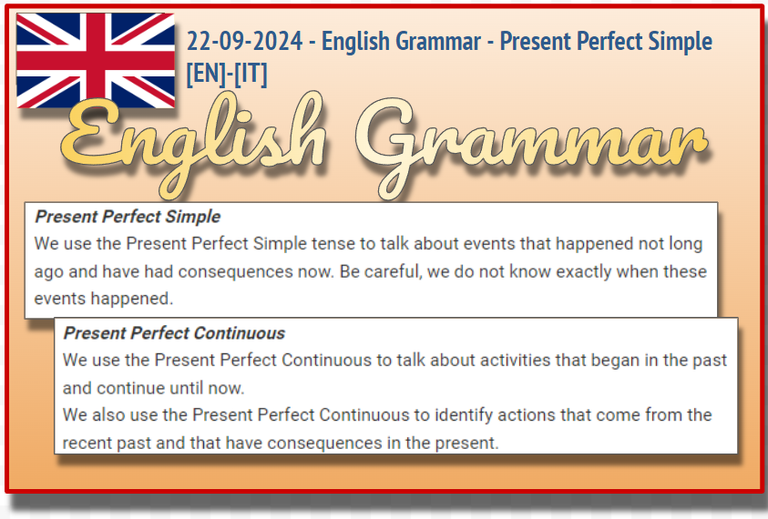
~~~ La versione in italiano inizia subito dopo la versione in inglese ~~~
ENGLISH
22-09-2024 - English Grammar - Present Perfect Simple [EN]-[IT]
With this post I would like to give a brief instruction regarding the topic mentioned in the subject
(code notes: X_85)
Present Perfect Simple
We use the Present Perfect Simple tense to talk about events that happened not long ago and have had consequences now. Be careful, we do not know exactly when these events happened.
How it is formed
The Present Perfect Simple is constructed with have/has + past participle of the verb.
In the case of regular verbs, you must add -d or -ed to the infinitive; if the verb is irregular, use its third form.
Examples
If we have to tell a friend of ours that Alessandro repaired the watch, we enter the case of the Present Perfect Simple. The action of repairing the watch has already occurred without knowing exactly when and this action has had a consequence that is reflected in now, that is, now the watch is repaired.
Below is the correct sentence where the form of the Present Perfect Simple is shown in bold.
Alessandro has repaired your watch.
Below I show the three forms that this sentence can have in the affirmative, negative and interrogative versions.
Affirmative
Alessandro has repaired your watch.
Negative
Alessandro hasn’t repaired your watch.
Interrogative
Has Alessandro repaired your watch?
Present Perfect Continuous
We use the Present Perfect Continuous to talk about activities that began in the past and continue until now.
We also use the Present Perfect Continuous to identify actions that come from the recent past and that have consequences in the present.
How is it constructed?
It is formed with the verb have/has been + Verb-ing
The case in which we use the Present Perfect Continuous is when we talk about actions that began in the past, but are continuing even now.
Example
For example, if we want to tell someone that we have been studying English since 2022, we are right within the conditions of this case.
The correct sentence with the Present Perfect Continuous form is the following (the transformations to the verbs are in bold)
I have been studyinging* English since 2005.*
Example 2
The Present Perfect Continuous is also used when we talk about actions that have happened recently but have a result in the present.
For example, if we want to say that our brother Patrick is tired because he worked hard, we are right in the case of the Present Perfect Continuous.
Here is the entire sentence with the Present Perfect Continuous verbs in bold.
Patrick is very tired. He has been workinging* hard.*
Conclusions
The Present Perfect Simple is used to talk about events that happened not long ago (but we don't know when) and have had results now, while the Present Perfect Continuous is used to talk about activities that began in the past and are continuing until now.
Question
Do you, like me, often confuse the Present Perfect Simple with the Present Perfect Continuous?

[ITALIAN]
22-09-2024 - Grammatica inglese - Present Perfect Simple [EN]-[IT]
Con questo post vorrei dare una breve istruzione a riguardo dell’argomento citato in oggetto
(code notes: X_85)
Present Perfect Simple
Il tempo del Present Perfect Simple lo usiamo per parlare di eventi che sono accaduti non molto tempo fa e hanno avuto conseguenze ora. Attenzione questi eventi che sono accaduti non sappiamo con precisione quando sono accaduti.
Come si forma
Il Present Perfect Simple si costruisce con have/has + participio passato del verbo.
Nel caso di verbi regolari bisogna aggiungere al verbo -d o -ed all'infinito; se il verbo è irregolare, usa la sua terza forma.
Esempi
Se dobbiamo dire ad un nostro amico che Alessandro ha riparato l'orologio entriamo proprio nel caso del Present Perfect Simple. L'azione di riparare l'orologio è già avvenuta senza sapere bene quando e questa azione ha avuto una conseguenza che si riflette ad ora, cioè ora l'orologio è riparato.
Qui di seguito la frase corretta dove in grassetto è mostrata la forma del Present Perfect Simple.
Alessandro has repaired your watch.
Qui di seguito mostro le tre forme che può avere questa frase nella versione affermativa, negativa e interrogativa.
Affermativa
Alessandro has repaired your watch.
Negativa
Alessandro hasn’t repaired your watch.
Interrogativa
Has Alessandro repaired your watch?
Present Perfect Continuous
Usiamo il Present Perfect Continuous per parlare di attività che sono iniziate nel passato e continuano fino ad ora.
Usiamo il Present Perfect Continuous anche per identificare azioni che provengono dal passato recente e che hanno conseguenze nel presente.
Come si costruisce?
Si forma con il verbo avere/è stato + Verbo-ing
Il caso in cui usiamo il Present Perfect Continuous è quando parliamo di azioni che sono iniziate nel passato, ma che stanno continuando anche adesso.
Esempio
Ad esempio se vogliamo riferire a qualcuno che noi stiamo studiando inglese dal 2022 siamo proprio all'interno delle condizioni di questo caso.
La frase corretta con la forma del Present Perfect Continuous è la seguente (in grassetto le trasformazioni ai verbi)
I have been studying* English since 2005.*
Esempio 2
Il Present Perfect Continuous si usa anche quando parliamo di azioni avvenute di recente che hanno però un risultato nel presente.
Se ad esempio vogliamo dire che il nostro fratello Patrick è stanco perché ha lavorato duramente, entriamo proprio nel caso del Present Perfect Continuous.
Qui di segito la frase intera con i verbi del Present Perfect Continuous in grassetto.
Patrick is very tired. He has been working* hard.*
Conclusioni
Il Present Perfect Simple si usa per parlare di eventi che sono accaduti non molto tempo fa (ma non sappiamo quando) e hanno avuto risultati ora, mentre il Present Perfect Continuous si usa per parlare di attività che sono iniziate nel passato e continuano fino ad ora.
Domanda
Anche voi come me confondete spesso confondete il Present Perfect Simple con il Present Perfect Continuous?
THE END